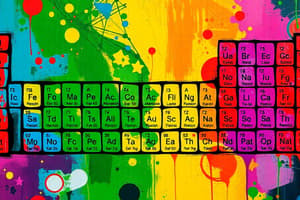Podcast
Questions and Answers
What are the three main components of an atom?
What are the three main components of an atom?
- Nucleons, leptons, quarks
- Ions, isotopes, molecules
- Protons, electrons, neutrons (correct)
- Electrons, positrons, neutrons
Which type of chemical reaction involves the transfer of one element from one reactant to another?
Which type of chemical reaction involves the transfer of one element from one reactant to another?
- Combustion
- Precipitation
- Single displacement (correct)
- Double displacement
What is the defining characteristic of a covalent compound?
What is the defining characteristic of a covalent compound?
- It involves the transfer of electrons between atoms.
- It shares electrons between atoms. (correct)
- It consists of metal cations and anions.
- It contains ions held together by electrostatic forces.
Which group of compounds release energy when they chemically combine to form a compound?
Which group of compounds release energy when they chemically combine to form a compound?
What is the pH range for bases?
What is the pH range for bases?
What characterizes a strong acid or base compared to a weak acid or base?
What characterizes a strong acid or base compared to a weak acid or base?
What is the primary focus of chemistry as a branch of science?
What is the primary focus of chemistry as a branch of science?
Which field of chemistry involves the study of atomic number, electron configuration, and recurring chemical properties?
Which field of chemistry involves the study of atomic number, electron configuration, and recurring chemical properties?
In a chemical reaction, what are the starting chemicals that interact to produce new products called?
In a chemical reaction, what are the starting chemicals that interact to produce new products called?
Which element group in the periodic table includes elements like sodium and potassium?
Which element group in the periodic table includes elements like sodium and potassium?
What condition must be met for a chemical reaction to occur spontaneously?
What condition must be met for a chemical reaction to occur spontaneously?
What type of properties do elements exhibit due to the specific distribution of electrons in their atoms?
What type of properties do elements exhibit due to the specific distribution of electrons in their atoms?
Study Notes
Chemistry
Chemistry is a branch of science that studies matter, its properties, how it interacts with energy and other forms of matter, and the substances formed when one substance reacts with another. It includes various fields such as organic chemistry, analytical chemistry, biochemistry, physical chemistry, chemistry education, forensic chemistry, nuclear chemistry, astrochemistry, solid state chemistry, supramolecular chemistry, green chemistry, and materials science. In this article, we will focus on five fundamental aspects of chemistry: the periodic table, chemical reactions, atomic structure, molecules and compounds, and acids and bases.
Periodic Table
The periodic table is a tabular arrangement of the chemical elements, organized based on their atomic number, electron configuration, and recurring chemical properties. These elements can be metals, nonmetals, metalloids, lanthanides, actinides, alkali metals, alkaline earth metals, transition metals, posttransition metals, noble gases, and halogens. Each element has a unique set of properties due to the specific distribution of electrons in its atoms.
Chemical Reactions
A chemical reaction involves the rearrangement of atoms between reactants to form products. The reactants are the starting chemicals; they interact to produce new products with different combinations of atoms. For a reaction to occur spontaneously, the enthalpy change must be negative (ΔH < 0) for the reaction to release heat. Chemical reactions often follow balanced equations, which specify the quantities of reactants and products involved in the reaction. Some common types of chemical reactions include combustion, single displacement, double displacement, acid-base neutralization, and precipitation.
Atomic Structure
Atoms are the smallest unit of a chemical element that retains all the properties of that element. They consist of three main components: protons, neutrons, and electrons. Protons have a positive charge (+), while electrons have a negative charge (-). Neutrons have no charge. Most atoms have a central nucleus containing protons and neutrons surrounded by a cloud of electrons. The atomic numbers of the elements are determined by the number of protons in their atomic nuclei. Electrons occupy a series of energy levels called shells, with each shell having a maximum capacity based on the principal quantum number, n.
Molecules and Compounds
Molecules are groups of two or more atoms bonded together. The type of bond holding these atoms together determines the overall behavior of the molecule, including its stability, polarity, and reaction rates. A compound is a pure substance composed of two or more elements chemically bound together in fixed proportions. When elements combine chemically, they typically release energy and form a compound with a higher molecular mass than the individual elements. Common types of compounds include ionic compounds, covalent compounds, and coordination compounds.
Acids and Bases
Acids and bases are important concepts in chemistry, as they play significant roles in many chemical processes and biological systems. An acid is a substance that donates a hydrogen ion (H+), and a base is a substance that accepts a hydrogen ion. Acids have pH values less than 7, while bases have pH values greater than 7. Many acids contain the hydroxyl group (-OH). Strong acids completely dissociate into their constituent ions in solution, while weak acids only partially dissociate. Similarly, strong bases also completely dissociate into their ions in solution, while weak bases do not.
Studying That Suits You
Use AI to generate personalized quizzes and flashcards to suit your learning preferences.
Description
Test your knowledge of fundamental chemistry concepts including the periodic table, chemical reactions, atomic structure, molecules and compounds, and acids and bases. Explore key aspects of chemistry in this quiz!




